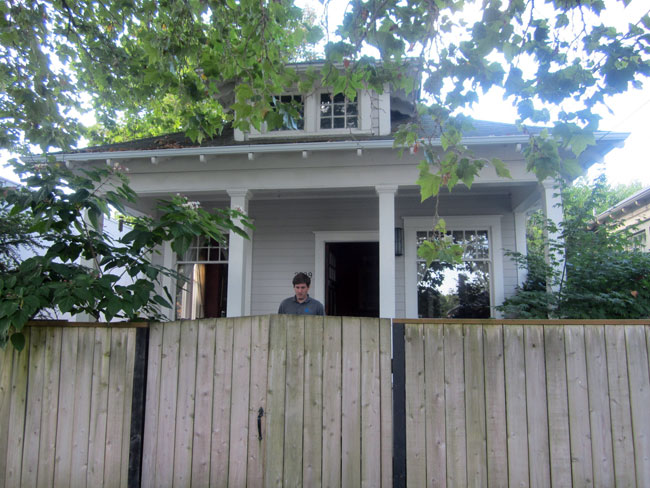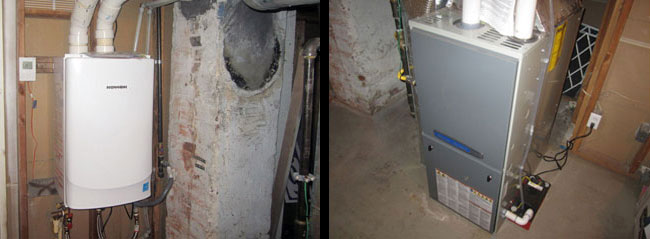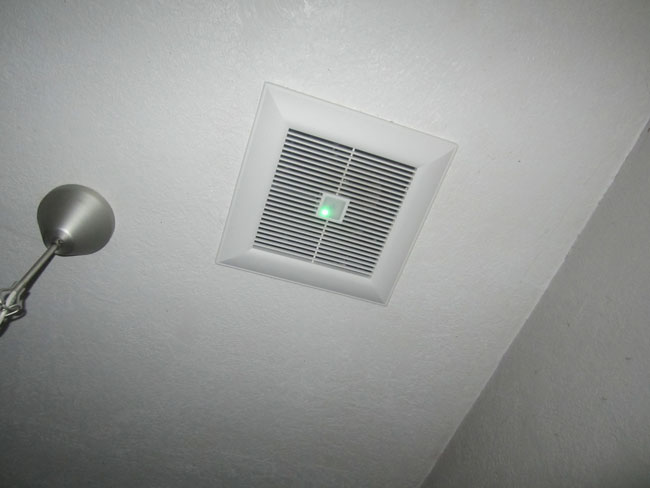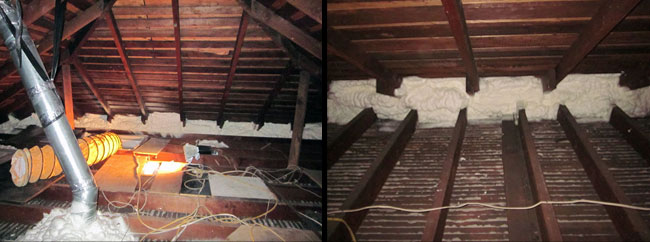Clean Energy Works Oregon’s rebates and financing allowed client to take high performance approach to improving home.
(Editor’s Note: this post is by Skylar Swinford, head of Hammer & Hand’s team of building scientists.)
It was a unique birthday present, no question. Jody’s friends in the office organized themselves and pooled resources to get insulation added to her 1912 house in Northeast Portland.

The 1912 Craftman bungalow is located at the boundary between Portland’s Eliot and Irvington neighborhoods.
It’s not a huge place, 1300 SF in total, but Jody was always cold at home. Unbeknownst to her or her friends, though, simply blowing insulation into the walls wasn’t going to have the impact on her house that everyone hoped. It just wasn’t the right approach. But there was no way to know this without an expert analysis of the home by technicians trained in building science, aka a home energy audit or home performance assessment.
Fortunately, just as the birthday gift was shaping up, Clean Energy Works Oregon launched and began offering all sorts of good rebates for home performance assessments and improvements. Just in time for Jody. She signed up for the program both to receive the free home energy audit and for the program’s rebates and financing. This was key, because it meant that she could take a more high performance approach to the project, rather than just band-aiding attic insulation over what we later learned was unsafe wiring.
So, as a contractor with the Clean Energy Works Oregon program, Hammer & Hand conducted a full assessment of the house and uncovered both the sources of her home’s performance problems as well as some critical safety issues.
Through the blower door test and safety testing we found that, in addition to bad attic insulation, Jody’s house had no wall insulation. We also found unsafe electrical work throughout the home, some pieced together from previous remodels and contractors, some original knob and tube wiring. She also had an old inefficient furnace and a back-drafting hot water heater. This last problem was being caused by an overly-powerful kitchen exhaust hood – despite how leaky her house was, the fan was strong enough to pull carbon monoxide exhaust fumes from the hot water heater right into the house.
Unfortunately, this is an all-too common occurrence in homes.
So, the first priority was to address the safety issues in Jody’s house. We initially planned to install a high efficiency, super-insulated-tank hot water heater. But after modeling it in our energy software, the financing cost of the electrical unit was more than the monthly savings that it brought. Instead, we upgraded to a tankless gas water heater that takes up less space and doesn’t waste energy by storing hot water. We also upgraded the old furnace to a 96.7 percent efficient high efficiency gas furnace that has a sealed combustion process similar to the one in the tankless hot water heater.

The tankless water heater (left), and 96.7% efficient furnace (right).
So now the combustion process of both the water heater and the furnace are sealed from the house, each with their own dedicated intake and exhaust flues. Not only are they more efficient, they’re extremely safe and will not be influenced by future alterations to the house. And because the units allow so little heat energy to escape through exhaust air, these pipes can be plastic. Metal flue pipes have gone the way of the coal engine!
To address the electrical safety issues in the attic and the walls, our electrician upgraded all knob and tube wiring to eliminate fire and electric hazard caused by covering wiring with insulation.
We installed a high-performance WhisperGreen continuous exhaust fan that, almost silently, provides the necessary air changes for the house in an efficient and controlled manner. This is one of the most critical pieces to the retrofit, because it will ensure Jody’s house has no moisture build-up during the winter and that she always has fresh air.

The WhisperGreen continuous exhaust fan.
For the insulation work in the attic we went with the “suck, seal and blow” technique, a term coined by our colleague Russ Hellem at Energetechs. The first step is to remove the existing insulation. Second, meticulous air sealing throughout. Finally, blow in a thick blanket of r50 cellulose insulation.

Attic insulation work underway.
For the walls, we injected high-density cellulose insulation. To do this we usually remove rows of the existing siding on a house to drill in and inject the cellulose. But in this house we weren’t able to do that because it has shiplap siding. Instead, we had to drill through the siding to inject the walls. Many people are afraid of drilling through siding like this because they are concerned about the appearance of the plugs afterward, but out experienced installers carefully sand the plugs until they blend in with the old siding texture. Once painted, the plugs are barely noticeable.

Plugs before painting (left) and after (right).
We also added spray foam insulation to the basement rim joists for air sealing and to help combat stack effect.

Spray foam at basement rim joists.
The team did a great job of sealing up Jody’s house. It’s become much quieter, cool on hot days, warm on cool ones. But along the way we also addressed the efficiency and combustion safety of the home’s mechanicals and the safety of the home’s wiring.
With the financing program and rebates offered by Clean Energy Works Oregon it was a no-brainer for Jody to make the investment and totally transform the way her home feels and performs. Even without the savings she now enjoys on energy bills, she told me it was worth the investment because she feels good about saving energy, she loves the fresh air in the house, her bathroom exhaust fan does its job, she has a safe water heater that no longer pollutes her indoor air, the furnace efficient and safe, and her electrical wiring has been updated from the stone ages. The fact that she’s saving money on utilities is just icing on the cake.
The lesson from Jody’s project? You don’t just do a home energy retrofit to save money on your monthly bill – you do it to transform your home into a high performance building, bringing it into the 21st century.
– Skylar
P.S. If you’d like to take advantage of the instant rebates and no-money-down financing of Clean Energy Works Oregon for your house, visit cewo.org and enter the rebate code “CNHHA” on the online application.
Back to Field Notes